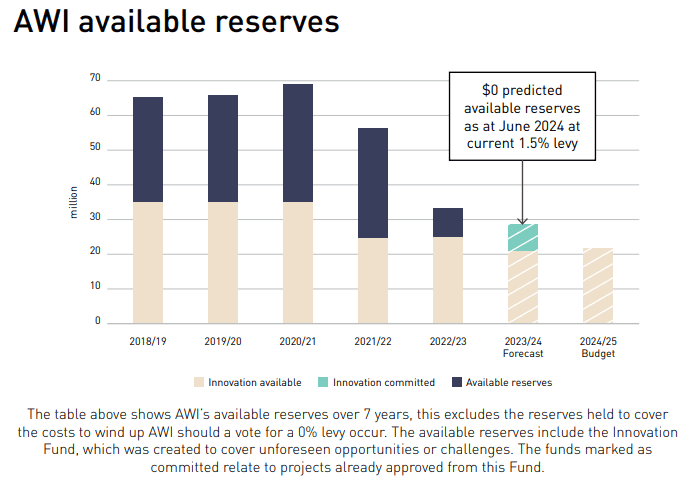
AUSTRALIAN Wool Innovation has released details of research, development and marketing activities that might be retained or cut if growers vote for a 2 percent or lower levy in the 2024 WoolPoll ballot.
In the voter information memorandum for the ballot approved by then Minister for Agriculture Fisheries and Forestry Murray Watt last week and now on wool.com/woolpoll, AWI predicts that at the current 1.5pc levy it will have zero available reserves at June 2024 with none projected over the next three years.
WoolPoll regulations prescribe four levy rates and allows AWI to propose an additional levy rate for shareholders to consider; however, this year the AWI board has not applied to list a fifth option, so in the 2024 ballot, growers will vote on the options of zero, 1pc, 1.5pc and 2pc.
If growers approve a zero levy in WoolPoll, AWI is suggesting that the company would be forced to close and with a 1pc levy, there might be no investment in its Breeding Leadership program, in flystrike vaccine research, sheep classing workshops, nor in eco-credentials or methane emissions research. A 1pc levy might also result in reduced investment in capacity building, local and flystrike extension activities, shearer training, marketing and bio-harvesting research.
A 2pc levy could lead to a 30pc reduction in marketing spend and in wild dog control programs, with priority given to investment in shearer training, emerging markets, visual scoring tools, capacity building and sheep classing, and continued research into flystrike vaccine, internal parasites and wool’s environmental credentials.
Although the VIM seems an obvious pitch from AWI to garner grower support for a 2pc or higher ballot result, the AWI board’s formal levy recommendation is not expected until early September.
The 2024 WoolPoll voter information kit with ballot paper with the levy options will be emailed to eligible shareholders from 20 September.
WoolPoll chair Rich Keniry encouraged all eligible voters to talk to their families, farm managers, business partners and employees to get their view on what they want to invest in the industry.
“WoolPoll only comes around every three years, so it’s vital wool growers vote for a levy rate that suits them,” he said.
“Ultimately, you get what you pay for.
“WoolPoll is the best opportunity wool growers have to define what they pay and what they get back in return.”
“Eligible voters should visit wool.com/woolpoll to read about the options available to them, while also checking their contact details are up to date so they can receive the Voter Information Kit in September via mail,” he said.
WoolProducers Australia chief executive officer Jo Hall said WoolProducers will be meeting in mid-August to determine if the body will be make a levy recommendation to growers, based on thorough consideration of the information related to each levy option.
“In the meantime, WoolProducers would encourage growers to familiarise themselves with the content of the VIM so that they too can make an informed decision on what they believe is an appropriate amount of levy that they contribute to AWI when they receive their voting papers later in the year.”
WoolPoll voting opens on 20 September 2024 and closes on 1 November 2024.

Dear Editor,
Not one letter, not one comment.
It appears from your article above AWI is heading for wind-up.
Are growers concerned? Perhaps not.
I am thinking that AWI wants a higher levy to support their idea of more of the same. Unfortunately for the industry this is a failure of an organisation.
If they promoted the production of a highly fertile plain-bodied Merino that didn’t need to be mulesed, was easy to shear and reared large numbers of lambs most of the problems would be solved.
As such, a levy of 1.5 percent would be ample as there would be more wool on the market that the end user wanted and the exodus from the industry would stop.
With this, the industry could turn into a vibrant and progressive one, with young people happy to stay in the industry.
The work has been done to put progress in place, it just needs AWI to get on side and drive a progressive industry.
Doug,
I would argue that at the grass roots the industry is very progressive and innovative. The problem is the lack of leadership; the dead hand of AWI.
Failure by AWI to marshal the industries resources to achieve what should have been our breeding objective of the last 20 years, a national flock of non-mulesed branded wool, says everything.
You are so correct Don. But there is none so deaf as those who don’t want the hear.